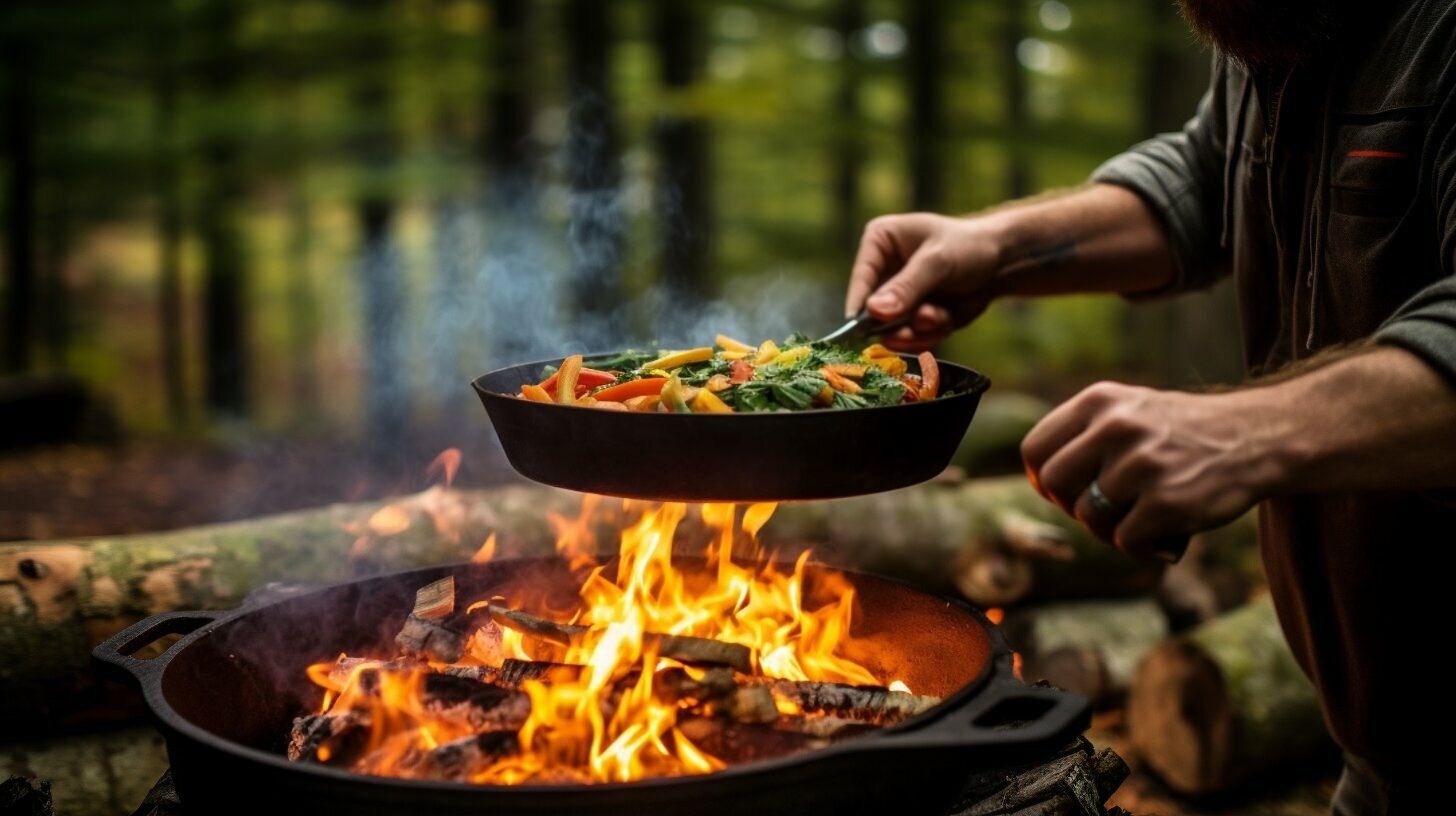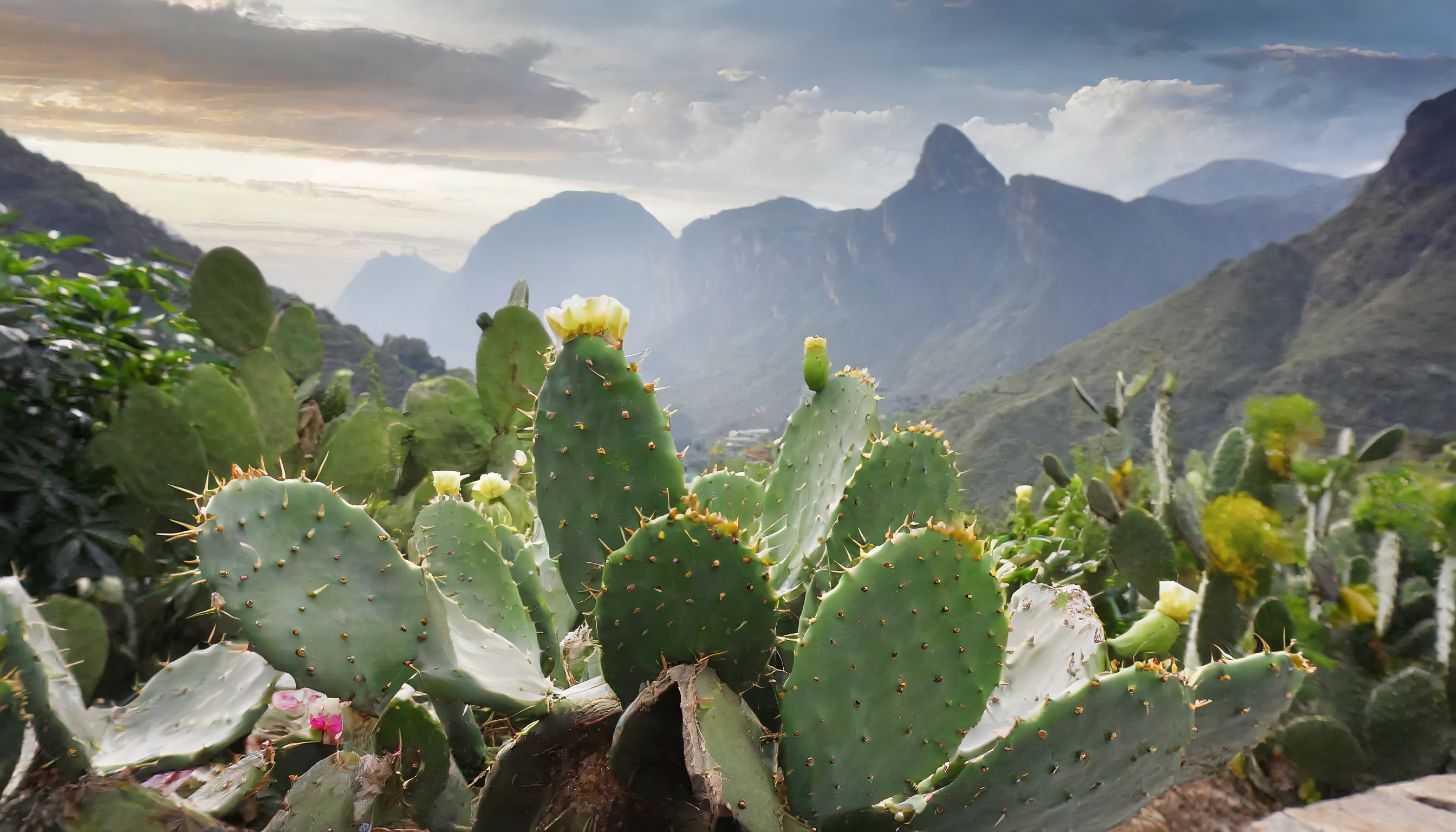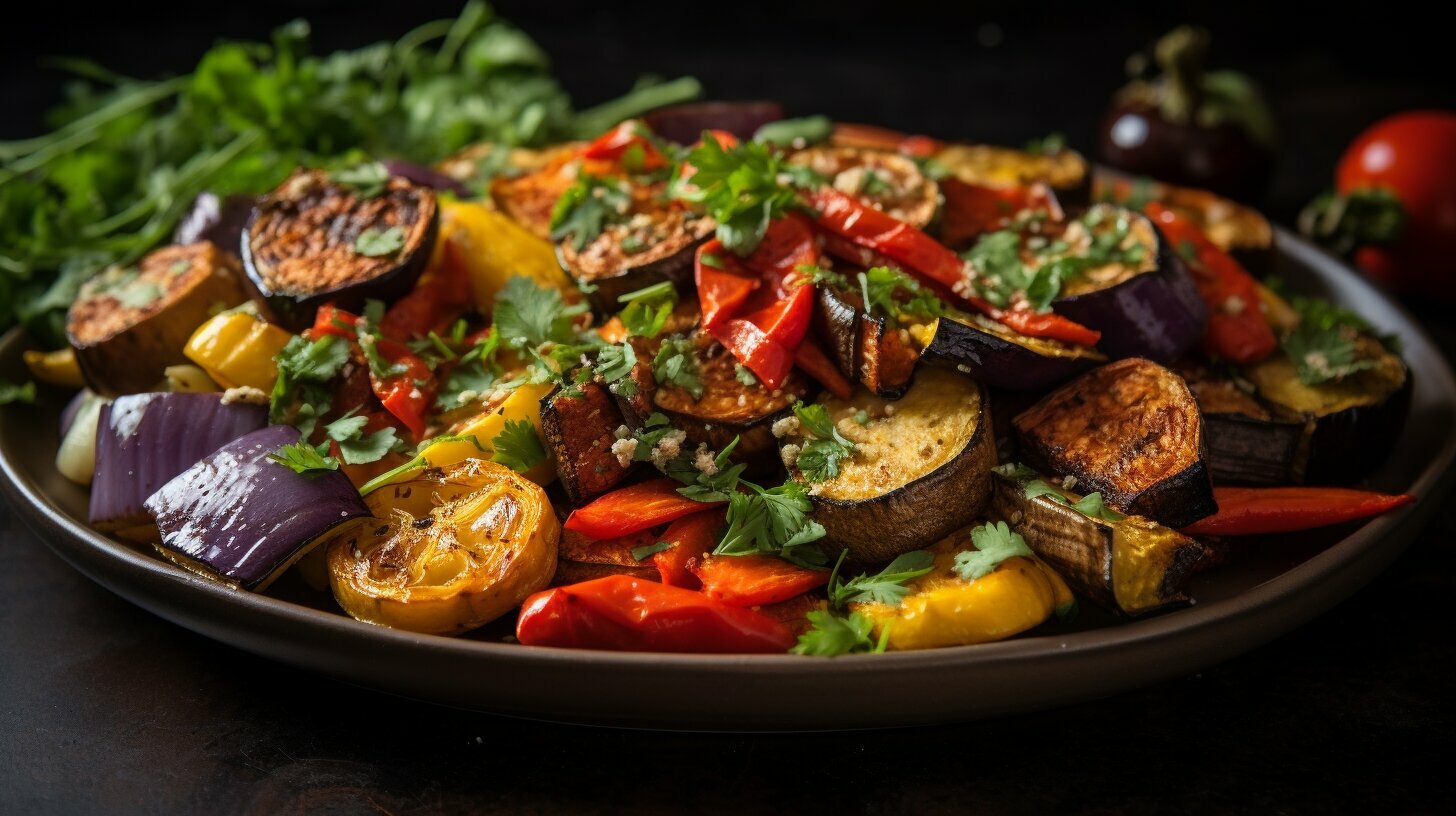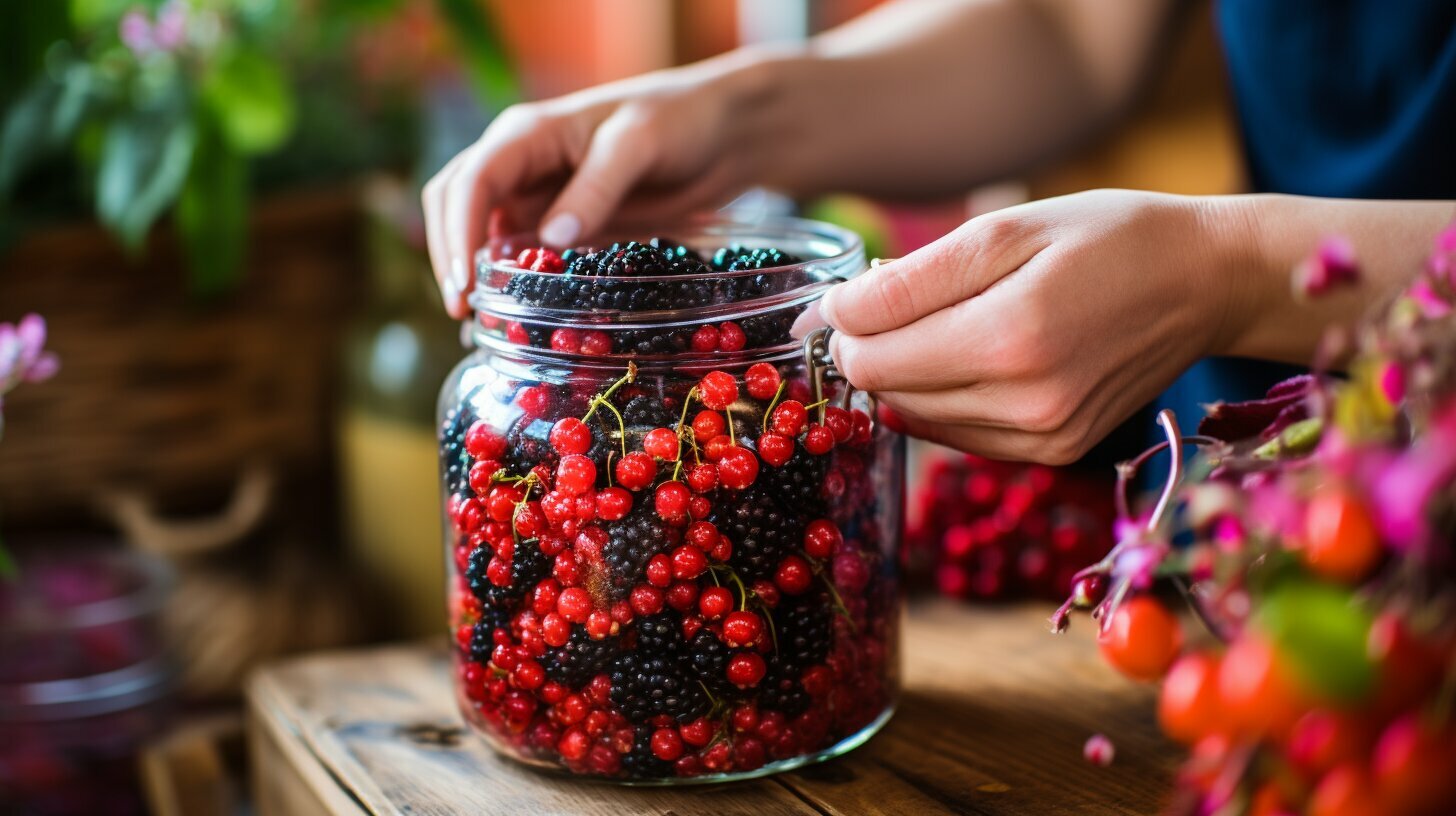There’s something magical about cooking in the great outdoors. Whether you’re cooking over an open flame, foraging for wild ingredients, or using primitive cooking methods, wilderness cooking techniques offer a unique experience that simply can’t be replicated in a traditional kitchen. However, cooking in the wild also comes with a new set of challenges – limited resources, unpredictable weather, and unfamiliar terrain.
In this comprehensive guide, you will learn a variety of outdoor cooking methods that will help you prepare delicious meals using limited resources. From campfire cooking techniques to foraging and cooking, you’ll learn how to make the most of the natural world around you. Whether you’re an experienced outdoorsman or a novice camper, this guide is the perfect resource for mastering cooking methods in the wild.
Key Takeaways
- Learn a variety of cooking techniques to use in the wilderness
- Understand the unique challenges of cooking in the wild
- Explore the different methods for preparing food in the wild, including campfire cooking, foraging, and solar cooking
- Discover the basics of primitive cooking methods
- Expand your culinary skills and create memorable dining experiences in nature
Introduction to Cooking in the Wild
When you’re venturing out into the great outdoors, being able to prepare your own food is an essential survival skill. Cooking in the wild presents unique challenges and opportunities, from adapting to different environments to making the most of natural resources.
If you’re new to wilderness cooking techniques, it’s important to understand the basics before you get started. Outdoor cooking methods can range from open fire cooking to using portable stoves, and each approach has its own advantages and disadvantages. By mastering a variety of wilderness cooking techniques, you can prepare nutritious and delicious meals no matter where your adventures take you.
Disclosure: When you buy through links on our site, we may earn an affiliate commission.
In the sections below, we’ll explore some of the most popular methods for wilderness cooking, including campfire cooking techniques, Dutch oven cooking, and primitive cooking methods. Whether you’re planning a camping trip or simply enjoying a day hike, these techniques will help you prepare tasty and satisfying meals in the great outdoors.
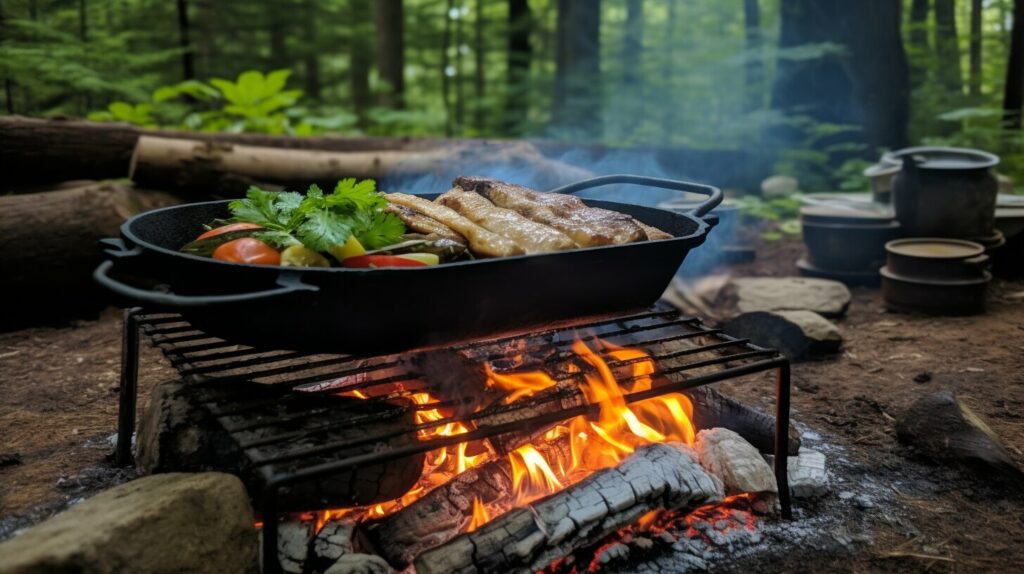
Campfire Cooking Techniques
When it comes to cooking in the wild, few methods are as classic and versatile as campfire cooking. Whether you’re grilling a steak or baking a cake, the open flame of a campfire can provide the heat you need to prepare delicious meals with limited resources.
Before you start cooking, it’s important to build and maintain a proper campfire. Choose a safe location away from trees and other flammable objects, and clear away any debris or brush. Build a fire pit by digging a shallow hole and surrounding it with rocks.
Next, gather dry wood, kindling, and tinder. Use small sticks, dry leaves, and bark as tinder to ignite the kindling. Once the kindling begins to burn, add larger pieces of wood to create a steady flame.
When the fire is established, set up your cooking area. You can use a grill or skewers to cook meat and vegetables directly over the flame, or wrap food in foil and place it in the coals to cook over time. You can also use a cast iron skillet or Dutch oven to cook stews, soups, and casseroles over the fire.
Remember to keep a close eye on your food while it’s cooking. Use a long-handled spatula or tongs to flip and rotate food as needed. And don’t forget to extinguish the fire completely before leaving your campsite.
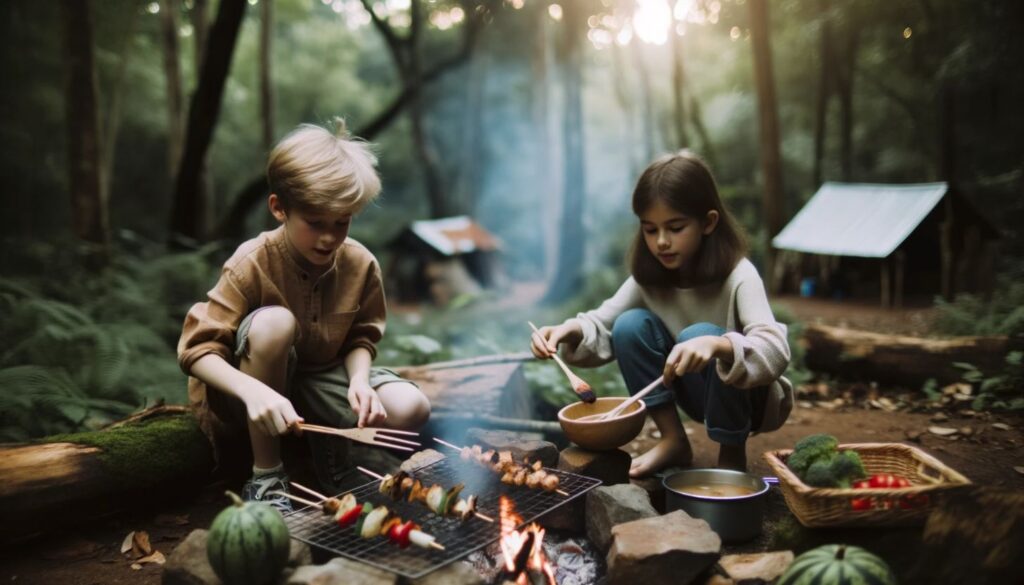
“Cooking around a campfire adds a unique flavor to your meals. You can experiment with different spices, rubs, and marinades to create your own signature dishes. And the best part? You get to enjoy your meal in the great outdoors!”
Foraging and Cooking
One of the joys of cooking in the wild is the opportunity to forage for fresh ingredients. Foraging and cooking go hand in hand, as wild foods can be a nutritious and flavorful addition to any meal. However, it’s essential to have a solid understanding of wild food preparation before consuming anything you’ve gathered.
Identifying edible plants: The first step in foraging is learning to identify edible plants. Invest in a good field guide or take a course in plant identification to increase your knowledge. Stick to plants you know are safe to eat, and avoid any mushrooms or other fungi unless you are an expert.
Gathering and cleaning: Once you’ve identified edible plants, harvest them carefully. Do not damage the plant or take more than you need. Rinse the plants thoroughly with clean water to remove any dirt, insects, or other debris.
Cooking wild foods: Wild foods can be cooked in a variety of ways, including boiling, steaming, frying, and roasting. Many wild foods also pair well with other ingredients, such as spices, herbs, and meats. Experiment with different flavor combinations to create unique recipes.
Precautions: While foraging and cooking with wild foods can be rewarding, it’s crucial to take precautions to ensure your safety. Familiarize yourself with poisonous plants in your area, and do not consume anything you cannot identify with certainty. It’s also essential to cook all wild foods thoroughly to kill any harmful bacteria or parasites.
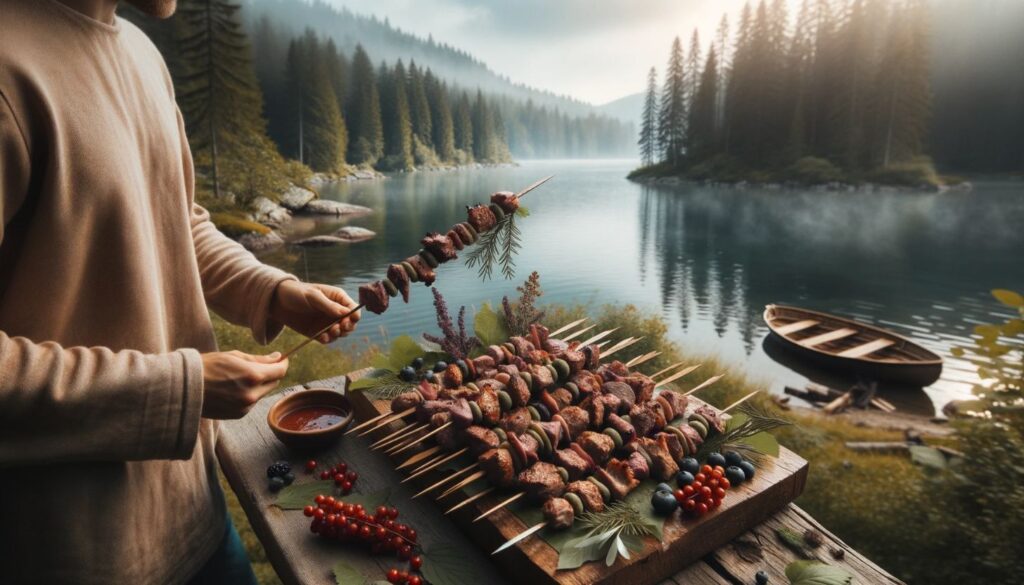
“Foraging and cooking with wild foods can be a fun and rewarding experience. Just remember to take the necessary precautions and always ensure you are consuming safe and edible plants.”
Dutch Oven Cooking
When it comes to outdoor cooking methods, few tools are as versatile and beloved as the Dutch oven. This heavy, cast-iron pot can be used to create a wide variety of meals over an open flame or with charcoal briquettes. The Dutch oven’s thick walls and tight-fitting lid make it an ideal choice for slow cooking and baking, while its sturdy construction means it can withstand the rigors of outdoor use.
To get started with Dutch oven cooking, you’ll need a few key ingredients, including your Dutch oven, a heat source, and your choice of recipe. Once you have your materials assembled, it’s time to build your fire. If you’re using charcoal briquettes, you’ll need to light them and let them burn until they are covered in a thin layer of white ash. If you’re cooking over an open flame, you’ll need to build a fire and let it burn down until you have a bed of hot coals.
Once your fire is ready, it’s time to start cooking. Place your Dutch oven on a stable surface, such as a rock or a metal stand, and arrange your coals or briquettes around it. If you’re cooking with charcoal, you’ll want to place a few briquettes on the bottom of the Dutch oven as well.
Now it’s time to add your ingredients. Dutch oven recipes can range from savory stews and casseroles to sweet cobblers and breads. One classic Dutch oven recipe is beef stew, which combines chunks of beef, potatoes, onions, and carrots in a rich and flavorful broth. Another popular option is peach cobbler, which features juicy peaches topped with a sweet and crumbly crust.
Cooking times will vary depending on your recipe and the temperature of your fire. As a general rule, it’s best to check your food periodically and add more coals or adjust the heat as needed. Keep in mind that the Dutch oven will retain heat for quite some time, so it’s important to let it cool down before cleaning and storing.
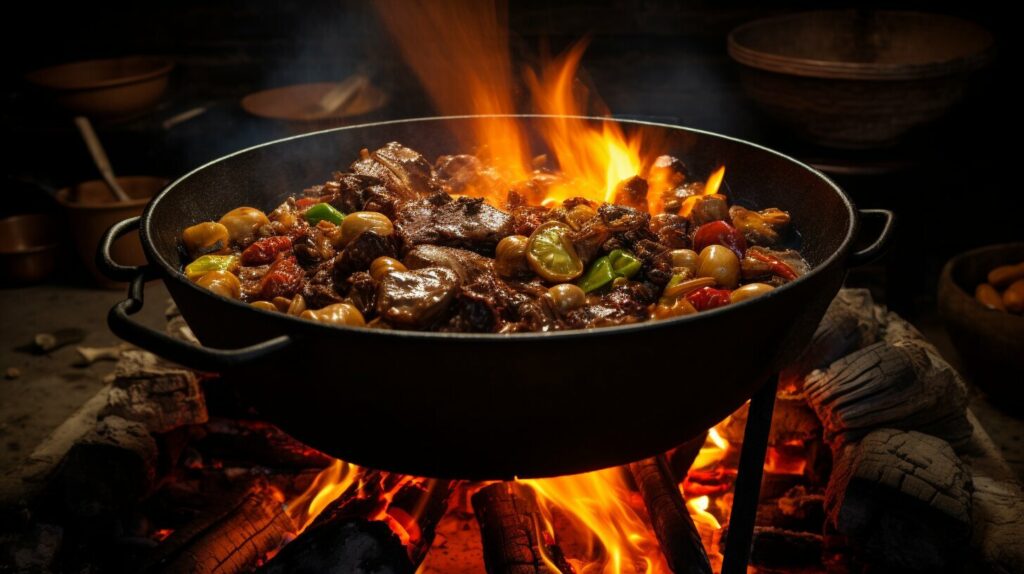
Whether you’re camping with friends, hiking through the wilderness, or simply enjoying a backyard barbecue, Dutch oven cooking is a classic outdoor cooking method that is sure to impress. With a little practice and experimentation, you’ll discover endless possibilities for delicious, hearty meals in the great outdoors.
Solar Cooking
When it comes to outdoor cooking methods, solar cooking is one of the most efficient and environmentally-friendly options. By harnessing the power of the sun, you can prepare meals using nothing more than the natural energy that surrounds you.
There are a variety of ways to practice solar cooking in the wild. One popular method is using a solar oven, which uses reflective panels to concentrate sunlight onto a pot or pan inside. Another option is a solar dehydrator, which uses the sun’s heat to dry and preserve food.
To use a solar oven, start by setting it up in a location that receives direct sunlight, such as an open field or a clear patch of ground. Place your food in a pot or pan, and then place it inside the oven. Make sure the reflective panels are angled towards the sun, and then sit back and let the oven do its work. Depending on the strength of the sunlight and the type of food you are cooking, it may take several hours for your meal to be fully cooked.
| Advantages | Disadvantages |
|---|---|
| – No need for fuel | – Efficiency varies based on weather conditions |
| – Environmentally friendly | – Longer cooking times than other methods |
| – Easy to use and maintain | – Limited cooking options |
While solar cooking may not be the fastest method, it is certainly one of the most sustainable and rewarding. By allowing nature to do the heavy lifting, you can savor your meal with the knowledge that you have minimized your environmental impact.

Smoking and Curing
Smoking and curing are ancient methods of cooking that have been used for centuries to preserve and flavor food. By smoking or curing meat, fish, and vegetables, you can extend their shelf life and add unique tastes to your dishes.
There are many ways to set up a smoking or curing apparatus in the wild. One easy method is to construct a simple smoker using natural materials such as branches, leaves, and mud. Another option is to use a portable smoker that can be carried with you on your outdoor adventures.
When smoking or curing food, it’s important to keep the temperature consistent and the smoke flowing. One traditional method of smoking involves using hardwood chips, such as hickory or mesquite, to create smoke. You can also try experimenting with different types of wood to achieve a variety of flavors.
Curing involves the use of salt, sugar, and other ingredients to draw out moisture from the food and preserve it. A simple curing method involves rubbing meat with a mixture of salt, sugar, and spices, and then allowing it to rest in a cool, dry place for several days. The result is a flavorful and tender meat that can be used in a variety of dishes.
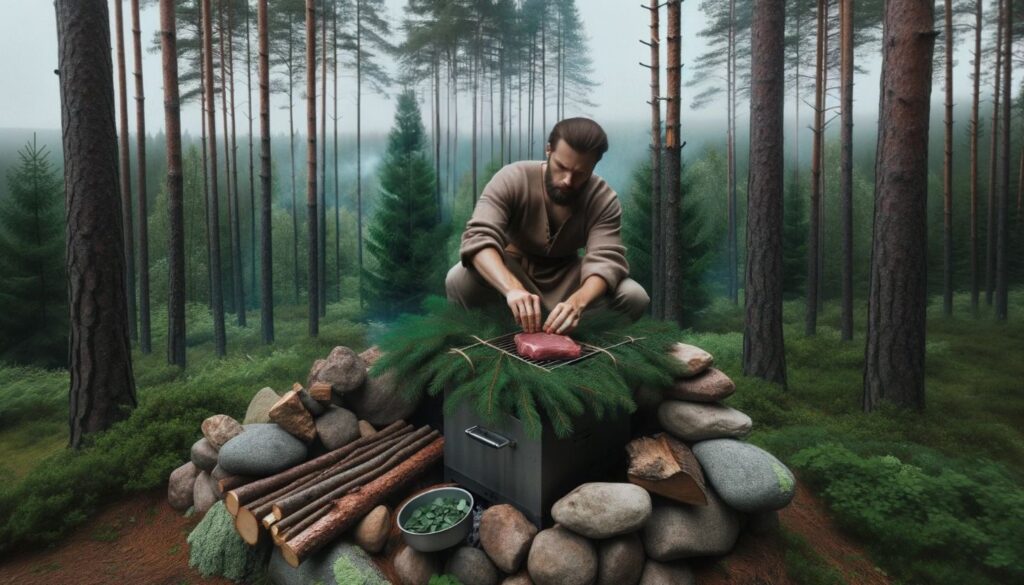
Both smoking and curing are primitive cooking methods that require patience and attention to detail. With practice, you can master these techniques and add a new dimension to your outdoor cooking repertoire.
Fireless Cookery
Fireless cookery is a valuable wilderness cooking technique that uses stored heat to prepare meals. Whether you’re on a camping trip or a long-term survival situation, fireless cookery is an excellent solution when you don’t have access to open flames. This technique also allows you to save fuel and minimize your impact on the environment.
Fireless cookery is based on the principle of insulation. By surrounding your food with insulating materials, you can trap heat and slow-cook your meals over several hours. This method is particularly useful for cooking stews, soups, and other dishes that can benefit from long, slow cooking times.
To prepare a fireless meal, you’ll need a well-insulated container. A standard cooler or an insulated bag can work well for this purpose, but you can also make your own insulating box using materials like cardboard and blankets. The key is to create a space that can trap heat and retain it for several hours.
Here’s how to use a fireless cooker:
- Start by heating your food to boiling point on a stove or campfire.
- Transfer the hot food into your insulated container.
- Immediately seal the container and place it in a warm location. You can even cover it with more blankets or towels to maximize insulation.
- Leave the container untouched for several hours. The heat stored inside will continue to cook your food without the need for additional fuel or heat.
Fireless cookery takes some practice to get right, but the results can be impressive. With a little patience and experimentation, you can create delicious, slow-cooked meals that are perfect for outdoor adventures.
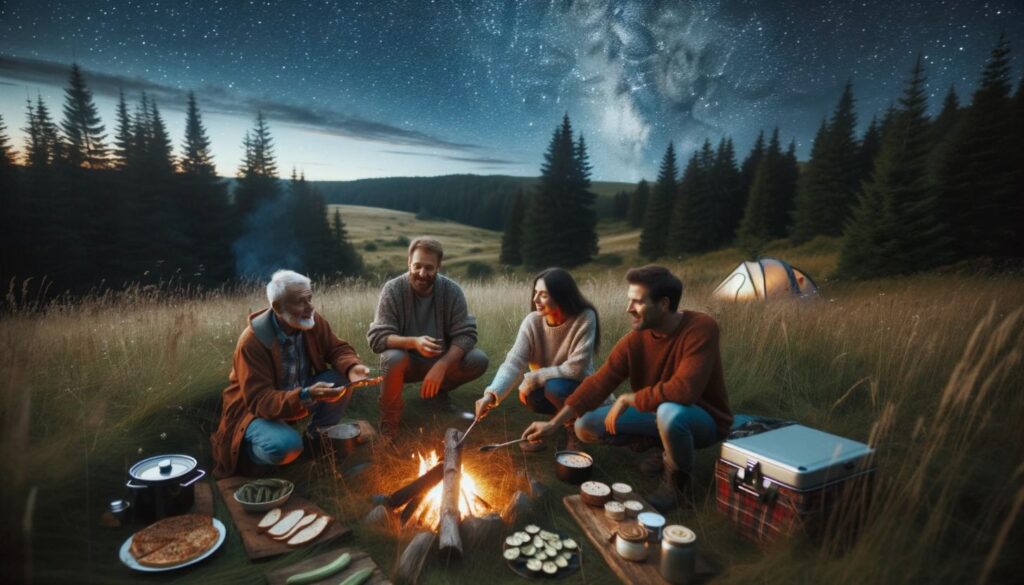
Cooking with Portable Stoves
When it comes to outdoor cooking methods, portable stoves are a popular and convenient choice. Whether you’re camping, hiking, or simply enjoying a day out in nature, a portable stove can make cooking a breeze.
There are various types of portable stoves available, including propane stoves, liquid fuel stoves, and canister stoves. Each type has its own set of features and benefits, so it’s important to choose one that suits your needs and situation.
Propane stoves are easy to use and provide a consistent flame, making them ideal for cooking meals that require precise temperature control. Liquid fuel stoves are versatile and can be used in extreme conditions, such as high altitudes or extreme cold. Canister stoves are lightweight and compact, making them a popular choice among backpackers and hikers.
When using a portable stove, it’s important to follow safety guidelines. Always use the stove on a flat surface and away from any flammable materials. Keep a fire extinguisher nearby in case of emergencies.
There are various campfire cooking techniques that can be adapted for use with portable stoves. You can use a frying pan or pot to cook meals, or even a specialized camping cookware set. With a portable stove, you can easily prepare a variety of meals, from simple one-pot dishes to more complex recipes.
| Fuel Type | Pros | Cons |
|---|---|---|
| Propane | Easy to use, consistent flame | Canisters can be heavy and bulky |
| Liquid Fuel | Versatile, can be used in extreme conditions | Can be messy and require maintenance |
| Canister | Lightweight, compact | Limited fuel capacity |
Here’s a simple recipe to get you started with portable stove cooking:
- Heat a tablespoon of oil in a frying pan over medium-high heat.
- Add chopped onion and cook for 2-3 minutes, until softened.
- Add sliced sausage and cook for another 2-3 minutes.
- Stir in diced potatoes and cook for 5-7 minutes, until tender.
- Crack eggs into the pan and cook to your preferred doneness.
- Season with salt and pepper, and serve hot.
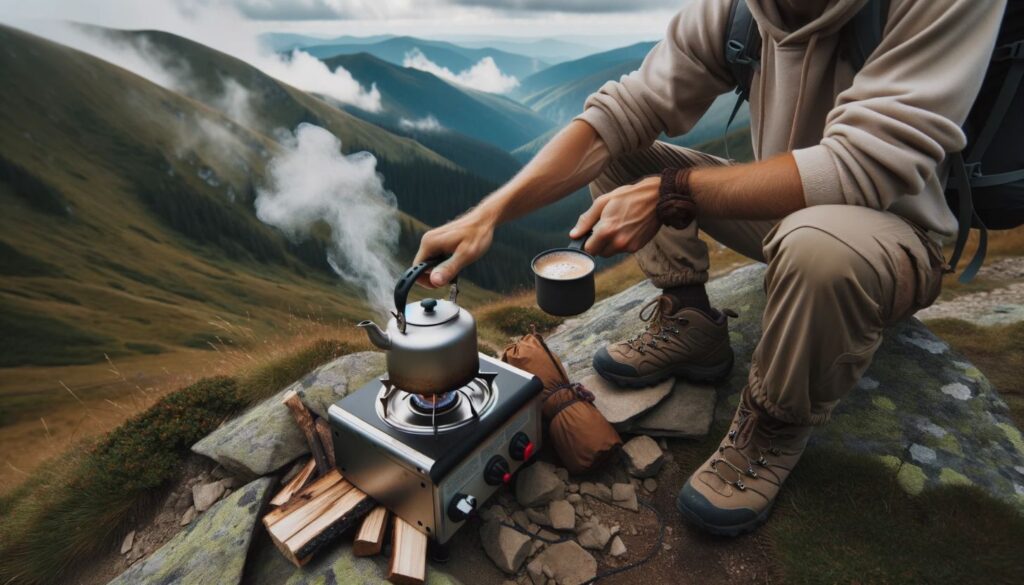
Primitive Cooking Methods
If you want to truly connect with nature and experience the thrill of survival cooking in the wild, then primitive cooking methods are the way to go. With these methods, you can use materials found in nature to cook your meals, just like our early ancestors did.
The most basic and widely known primitive cooking method is open fire cooking. Start by collecting dry wood and kindling to create a fire. Once the fire has burned down to a bed of hot coals, you can start cooking. Wrap your food in leaves, such as banana leaves or corn husks, and place it directly on the hot coals. This creates a unique smoky flavor and adds a touch of nature to your meal.
Another primitive cooking method involves using hot rocks to cook your food. Start by heating up rocks in a fire for several hours. Then, wrap your food in damp leaves and place it on a layer of hot rocks. Add another layer of hot rocks on top of the food and cover everything with dirt to seal in the heat. This creates an oven-like environment, slowly cooking your food to perfection.
Cooking with clay is another primitive technique that adds a unique flavor to your meals. To start, create a clay vessel using materials found in nature, such as clay and straw. Then, build a small fire and let it burn down to ash. Place your clay vessel in the ash and let it heat up for several hours. Once the vessel is hot enough, add your food and cover it with the lid. This creates a moist cooking environment that infuses your food with the earthy flavor of clay.
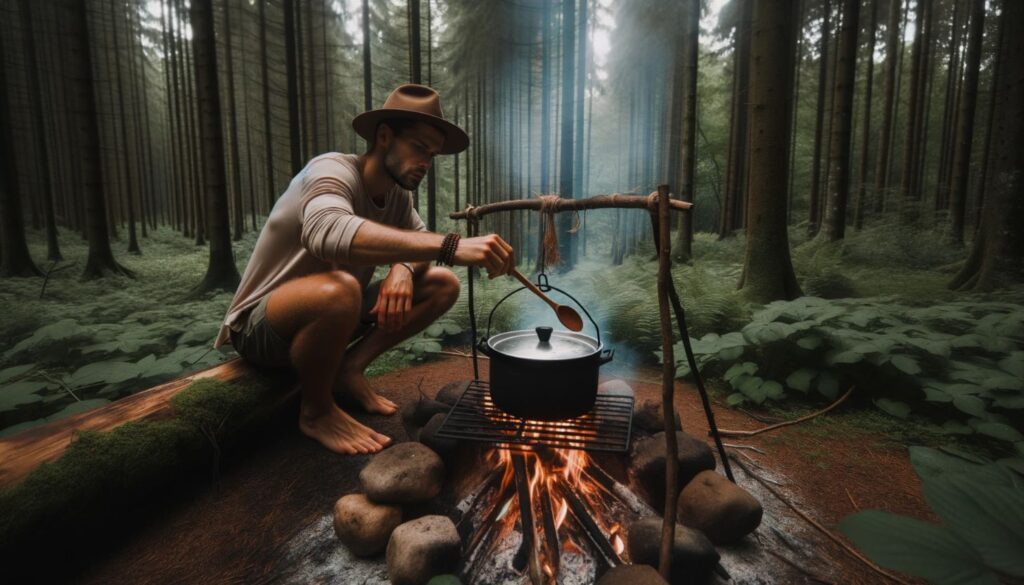
“Cooking with primitive methods allows you to experience the satisfaction that comes with cooking over an open flame, using natural materials to create a meal that nourishes not just your body, but your soul.”
While primitive cooking methods require more time and effort than other techniques, the experience is well worth it. The unique flavors and connection to nature that come with primitive cooking make it a truly unforgettable experience.
Conclusion
Venturing into the wilderness offers an unparalleled opportunity to connect with nature and master the art of outdoor cooking. By learning various techniques like campfire and Dutch oven cooking, you can prepare delicious meals with limited resources.
Remember key principles like choosing safe cooking locations, properly extinguishing fires, and avoiding damage to the environment. For an added challenge, try incorporating foraged ingredients or utilizing primitive cooking methods to gain a deeper appreciation of nature’s bounty.
As you refine your wilderness cooking abilities, continue exploring new recipes, methods, and innovative ways to cook outdoors sustainably. Joining outdoor cooking communities allows you to share your passion while learning tips and techniques from experienced enthusiasts.
With this guide providing a solid foundation, you now have the knowledge to create rewarding culinary experiences on your wilderness adventures. The skills you gain will lead to endless memorable meals cooked in the great outdoors.
FAQ
What are some cooking methods that can be used in the wild?
There are several cooking methods that can be used in the wild, including campfire cooking, Dutch oven cooking, solar cooking, smoking and curing, fireless cookery, cooking with portable stoves, and primitive cooking methods.
What are the principles of cooking in the wild?
Cooking in the wild requires adapting to different environments and making the most of natural resources. It involves using limited resources efficiently and creatively to prepare delicious meals outdoors.
How can I cook over a campfire?
To cook over a campfire, you can use techniques such as grilling, baking, or using a campfire cooking utensil. It’s important to know how to build and maintain a campfire properly to ensure safe and effective cooking.
How can I incorporate wild ingredients into my meals?
Foraging for wild edibles is a great way to add fresh and unique flavors to your meals in the wild. Learn how to identify and gather wild foods safely, then clean, prepare, and cook them using various techniques.
What can I cook using a Dutch oven?
Dutch ovens are versatile cooking vessels that can be used to make a wide range of meals, including stews, soups, roasts, bread, and desserts. They can be used over an open fire or with charcoal briquettes.
How can I utilize solar energy for cooking in the wild?
Solar cooking methods include using solar ovens and solar dehydrators. These allow you to harness the power of the sun to cook, bake, and preserve food while minimizing your environmental impact.
How can I set up a smoking or curing setup in the wild?
To smoke or cure food in the wild, you will need a smoking or curing setup. This typically involves creating a smoke chamber or using a fire pit with specific materials and techniques. It’s important to understand the basics of smoking and curing to ensure food safety and flavor.
What is fireless cookery?
Fireless cookery is a method of cooking that uses stored heat to prepare meals. It involves insulating food to retain heat and allowing it to cook slowly over time. This technique can be useful for extended trips or situations where open fires are not allowed.
How can I cook using portable stoves in the wild?
Portable stoves are convenient and efficient for cooking in the wild. Learn about different types of portable stoves, their features, and how to use them effectively. This includes understanding fuel options, safety tips, and recipes that can be prepared using portable stoves.
What are some primitive cooking methods I can try in the wild?
Primitive cooking methods involve using materials found in nature, such as hot rocks, clay, and leaves, to cook food. Explore ancient techniques and gain a deeper appreciation for the ingenuity of early humans.
How can mastering cooking methods in the wild enhance my outdoor experiences?
By mastering cooking methods in the wild, you can expand your culinary skills and enjoy delicious meals no matter where your adventures take you. It allows you to create memorable dining experiences in nature while making the most of limited resources.

